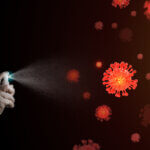A question we often hear from our clients is about the choice of microbes included in the standardized tests.
“Why these particular strains? Why not others?”
Choosing these specific microbial strains, whether bacterial or viral, is never arbitrary. For instance, let us look at EN 14476. This protocol determines the efficacy of chemical disinfectants under different conditions in which they are intended to be used.
According to the EN 14476 protocol, the organisms to be tested include the following:
| EN 14476 | Viruses Tested |
Full-spectrum virucidal activity |
PoliovirusAdenovirusMurine norovirus |
| Limited spectrum virucidal activity | AdenovirusMurine norovirus |
| Virucidal activity againstenveloped viruses | Vaccinia virus |
The viruses are chosen based on several factors, some of which are listed below:
- The type of viruses that are intended to be the target of the chemical compound with respect to the mode of transmission.
- The prevalence of the virus.
- The pathogenicity of the virus.
- The structural and the genetic phenotype of the virus, etc.
For instance, the Adenovirus, a nonenveloped virus with DNA as its genetic material, is highly common and present on various surfaces. Evaluating a clinical disinfectant against such a virus only highlights its efficacy in neutralizing a ubiquitous pathogen.
Additionally, the structure of these viruses plays a crucial role in figuring out how to combat them and eventually in the development of chemical disinfectants targeted at them.
Also Read: What does “Eliminates 99.9% Germs” Label mean?
Viral Structure
Now that we know how the pathogenicity and prevalence determine the inclusion of viral/bacterial strains in ISO/EN-ISO protocols, let us understand the basic viral structure. The critical structural difference among viruses is the presence or absence of the lipid-bilayer membranes or “envelope.” This fundamental contrast gives rise to distinct mechanisms of infection while allowing us to categorize them as “enveloped” and “non-enveloped.”
| Characteristics | Enveloped Viruses | Non-Enveloped Viruses |
| Host Entry | Membrane fusion | Perforate host cell membrane |
| Lipid Bilayer | Present | Absent |
| Components | Envelope + Nucleocapsid | Nucleocapsid |
| Sensitivity to heat, acid, drying, detergents | Sensitive (Labile) | Resistant (Stable) |
| Sensitivity to chemical disinfectants | High | Low |
| Examples | Hepatitis B virus, HIV, Coronavirus, Vaccinia virus | Poliovirus, Adenovirus, Norovirus |
For instance, the Poliovirus is small-sized, non-enveloped, with RNA as genetic material. At the same time, Norovirus and Adenovirus are large-sized and non-enveloped, with RNA and DNA as genetic material, respectively. The mechanism of infection, their sensitivity, their protein markers, etc., prove valuable in understanding how best to develop an effective disinfectant. Therefore, if a disinfectant is effective against the viruses mentioned above [for EN 14476], then there is a high probability that the disinfectant is effective against all other viruses with similar phenotypes.
Also Read: Top Facts about the JIS L 1902 Test Method
Microbe Investigations
At Microbe Investigations, we offer diverse microbiology testing services for clients working with antibacterial and antiviral formulations. These range from treated textiles to plastics, coatings, surface disinfectants, and specialized applications.
In case standard test methods are unsuitable for validating the efficacy of your product, we offer customized antiviral or antibacterial efficacy tests. Our team is available to help you determine the optimal test for your project, from microbiology consulting to the interpretation of the results.
Reach out to us in case of any queries.
OUR SERVICES
Antibacterial Test | Antiviral Test | ASTM E2149 | AATCC 100 | JIS Z 2801 | JIS L 1902 | EN 1276 | ISO 21702 | ISO 18184 | EN 14476 | ISO 22196 | ISO 20743 | ISO 17299-3 | Arm in Cage Test | Room Test | Tunnel Test | Olfactometer Test | Tick Repellent Test | Minimum Inhibitory Concentration Test | Zone of Inhibition Test | ISO 846 | ASTM E2180 | ASTM D7907-14 | ASTM E3031 | AATCC 147 | AATCC 30 | ASTM G21 | ASTM G29 | EN 16615 | EN 13697 | JIS L 1922









